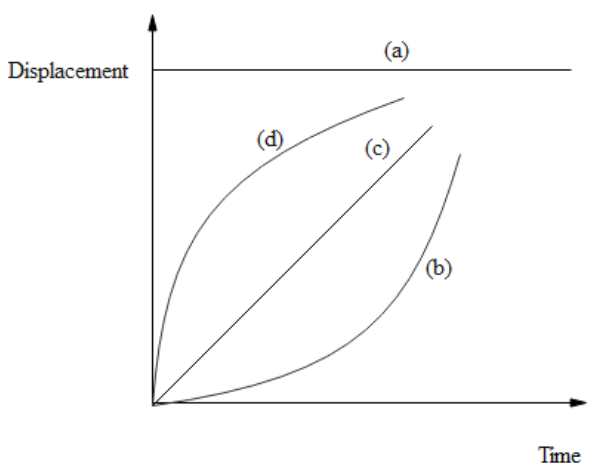
Displacement - time graphs of a body in motion along a line represented by four curves (a), (b), (c) and (d). Which of the curves indicated retardation motion?


Answer
586.5k+ views
Hint: We know that displacement is the act of moving something from its place or position. It is a vector quantity which defines the shortest path possible when travelling a distance. Since, it is a straight line following a certain direction, it is classified as a vector.
Completed step by step answer:
We know that if the velocity of a body is decreasing with respect to time, then the acceleration is said to be negative.
So, retardation is the rate of decrease in velocity.
The curve (a) represents a motion of a body which is having constant displacement with respect to the change of time.
The curve (b) represents an accelerated motion. The displacement of the body will gradually increase with change in time.
The curve (c) represents the uniform displacement of a body with respect to the change of time.
The curve (d) represents the retardation of the body. This is because with change of time the velocity decreases.
Hence, the correct answer is curve (d).
Note: The displacement-time graph here indicated velocity of a moving body. Acceleration defines velocity per unit time, so integrating this graph variable with a time variable we will get the mathematical acceleration or retardation of the body, while differentiating an acceleration graph variable with a time variable will simply give us the velocity of a body over a certain time period. Keeping these techniques handy will result in a quicker solution for such questions.
Completed step by step answer:
We know that if the velocity of a body is decreasing with respect to time, then the acceleration is said to be negative.
So, retardation is the rate of decrease in velocity.
The curve (a) represents a motion of a body which is having constant displacement with respect to the change of time.
The curve (b) represents an accelerated motion. The displacement of the body will gradually increase with change in time.
The curve (c) represents the uniform displacement of a body with respect to the change of time.
The curve (d) represents the retardation of the body. This is because with change of time the velocity decreases.
Hence, the correct answer is curve (d).
Note: The displacement-time graph here indicated velocity of a moving body. Acceleration defines velocity per unit time, so integrating this graph variable with a time variable we will get the mathematical acceleration or retardation of the body, while differentiating an acceleration graph variable with a time variable will simply give us the velocity of a body over a certain time period. Keeping these techniques handy will result in a quicker solution for such questions.
Recently Updated Pages
Master Class 9 Social Science: Engaging Questions & Answers for Success

Master Class 9 Science: Engaging Questions & Answers for Success

Master Class 9 English: Engaging Questions & Answers for Success

Master Class 9 Maths: Engaging Questions & Answers for Success

Master Class 9 General Knowledge: Engaging Questions & Answers for Success

Class 9 Question and Answer - Your Ultimate Solutions Guide

Trending doubts
Which places in India experience sunrise first and class 9 social science CBSE

Fill the blanks with the suitable prepositions 1 The class 9 english CBSE

Write the 6 fundamental rights of India and explain in detail

Difference Between Plant Cell and Animal Cell

What is pollution? How many types of pollution? Define it

What is the Full Form of ISI and RAW




